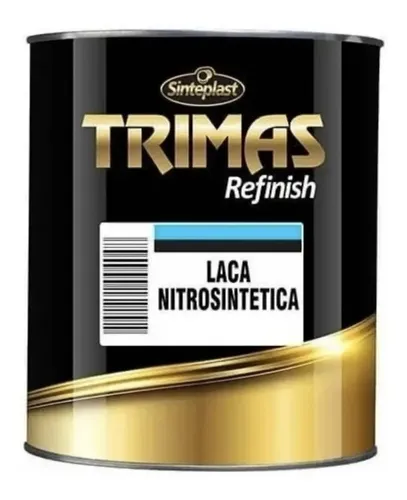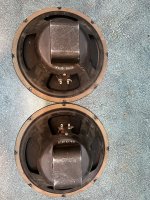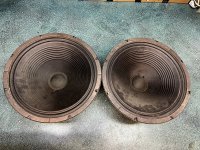JBL D120 is "ribbon" and has been used on guitar.Al ribbon, yes have thought about that but not aware of any. Prolly wouldn't be appropriate for 'gita sound'
Yes, I also think that double layer insulation is imprtant only with higher voltages between two adjacent wires. In voice coils it isn't.This double insulated Polyester is incredibly robust. As an example I wound an EL84 / 30W OP transformer with Bifilar primaries. I proof tested the primaries up to just over 1100V winding to winding and wasn't game to go higher which is quite amazing, especially for such fine wire.
Btw, bifilar winding of an output transformer results in unnecessarily high winding capacitance, unless you wind an unity coupling tranny.
Best regards!
Thanks for the link. I had found that article myself some time ago. Doesn't really specifically address the single vs heavy build question, but has lots of other useful information.This is worth a read, it covers quite a lot.
https://audioxpress.com/article/voice-coils-a-tutorial
I'm not concerned with making any high-temp (or otherwise high-tech) coils at the moment. I'll be using the old methods with simple round wire and low-temp adhesives. Roughly 15-25W power handling is the range I am expecting.
From what I can find, wet winding with nitrocellulose adhesives was standard for these types of speakers back in the day (correct me if I'm wrong). Has anyone ever tried an alkyd resin instead? While it's certainly possible to source nitrocellulose adhesives, alkyd resins are even easier to find.
I found this patent from 1973.I have wondered if aluminium ribbon could just use an anodized insulation layer?
Some MI/guitar speakers do have edgewound aluminum voice coils. @PRR mentioned JBL. Many of their MI speakers had edgewound coils. A few more examples I know of are the Electro-Voice EVM series, Altec MI speakers, Cetec-Gauss MI speakers (the 2841/4281 being one example), Beyma Liberty (intended to be similar the JBL E120), and the Eminence EM12(N) (intended to be similar to the EVM12L).Al ribbon, yes have thought about that but not aware of any. Prolly wouldn't be appropriate for 'gita sound' 🙂
These speakers sound different (of course) than the more popular low-tech Celestion/Jensen/etc. type, but they definitely have their fans.
Yes, but remember that in a normal voice coil , 2 layers starting and ending on the same side, the first and the last turns are superimposed, so there you have full drive voltage turn to turn.The turn-to-turn potential difference is only a volt or so,
In a 16 ohm speaker driven to 100W RMS (nothing over the top) voltage is 40V RMS, 70V peak , with a mild sinewave driven from a transistor amp.
If a Tube one, fly-back effect caused by those squarewaves turning on-off into a large inductor cause way higher voltage peaks.
That said, still well within any commercial wire enamel capabilities.
I have repaired speakers with a hole in the VC former you could put your pinky finger through, not kidding, but then I suspect a wire broke, creating a gap, and the arc burnt through everything around for 5 or 6 mm radius.
Arcs are about the hottest phenomena we can find in the Electronics field we deal with, incredibly high temperatures, very concentrated high power dissipation, bonus UV radiation, the works.
There´s a reason arc welders use one to melt significant masses of steel in fractions of a second, go figure.
Nitrocellulose adhesive is even easier to find 😉From what I can find, wet winding with nitrocellulose adhesives was standard for these types of speakers back in the day (correct me if I'm wrong). Has anyone ever tried an alkyd resin instead? While it's certainly possible to source nitrocellulose adhesives, alkyd resins are even easier to find.
It was replaced as an adhesive proper but is alive and well, in a more diluted form (no big deal) as car paint, also used as wood Nitro varnish.
You´ll find it as "Universal/Nitro Lacquer Base", under many brands, since it´s an "easy" product to make (100 year old technology).
https://www.sherwin-auto.com.br/en/

Sold as: "Laca Base Nitro Transparente Brillante X 0.875 Litros"
Search for same type at your friendly car painter supplier.
The one to use is transparent , not sure about US units but here the "1 liter" can comes actually loaded with 875cc "transparent base" (wink wink 😉 ) with space to add a 125cc squeeze tube or pouch of paste like pigment (to make up 1 full liter), the idea being that a car painter can mix many pigments to fine tune and exactly match any existing colour he finds.
I buy the transparent Base only, no pigments , and leave the can open.
A couple hours under the Sun in Summer or 3-4 days in a quiet shelf , with ventilation but not in a wind draft, of course away from open flame (like on ANY solvent based paint) and it thickens to "honey".
There´s your Nitro adhesive 😉
Back in the day it was so much used that it was called "speaker cement", go figure, and in my view is an important part of vintage sound.
Last edited:
The aluminium ribbon VCs that I have seen (mainly JBL) are all one layer e.wound AFAIK.Yes, but remember that in a normal voice coil , 2 layers,...on the same side, the first and the last turns are superimposed, so there you have full drive...
Does anyone do a multi-layer wound Ribbon?
It seems pointless unless it's inside + outside wound, that would work with ribbon but then there would be no problem with superimposed turns.
(Actually an inside + outside ribbon is exactly what I would like to try but a bit off topic in this "retro" thread)
Thanks to bmc0 for the reference to the patent, I expected someone would have tried it.
As to the carbon fiber, I wondered if you could make a stiffer, more durable paper, so you could make the cone thinner and even less heavy.
More efficient and potentially more "impact" (or "crisp" or "snappy" or whatever word is cool in the musical instrument world).
Best wishes
David
Last edited:
I mentioned "normal" voice coils 🙂 , which means 2 layer round wire, about 99.98% of Guitar speakers out there.
And in edgewound aluminum ribbon ones, you still have to bring winding end back "up", towards neck, to be able to attach it to tinsel wires.
Typically accomplished by bending flatwire "up" along the gap in VC former , tightly against all of the winding, including first turn, so one way or the other you can´t avoid it.
Only speaker I worked with and know personally (there may be others of course) which boldly runs the return wire over the main winding is Bose, I guess because its 1 ohm coil wire is too thick to fit inside the former gap anyway, and they HAD to cut a slot for it on the top plate, go figure.
Available space IS tight in a VC gap.
And in edgewound aluminum ribbon ones, you still have to bring winding end back "up", towards neck, to be able to attach it to tinsel wires.
Typically accomplished by bending flatwire "up" along the gap in VC former , tightly against all of the winding, including first turn, so one way or the other you can´t avoid it.
Only speaker I worked with and know personally (there may be others of course) which boldly runs the return wire over the main winding is Bose, I guess because its 1 ohm coil wire is too thick to fit inside the former gap anyway, and they HAD to cut a slot for it on the top plate, go figure.
Available space IS tight in a VC gap.
Yeah, but you quoted me, and I specifically mentioned Aluminium ribbon but you left that part out 😉 .I mentioned "normal" voice coils 🙂
No problem, always interested to learn more of the practical side from your hands-on experience.
The return wire issue is part of the reason why I am interested in a two layer inside/outside VC.
It both saves a little of the precious space and keeps the first and last turns well separated.
But a bit off topic here, unless bmc0 wants to build his retro speaker with a state of the art VC.
Best wishes
David
Yeah, I know there are a few edge wound Al VC 'guitar' speakers. Various JBL's (D120) and arguably most famous is EVM12L.JBL D120 is "ribbon" and has been used on guitar.
BMC was using a Celestion as his reference so these high power US speakers are quite different in tone.
Personally I prefer the British speakers but definitely some great tones made with the former. Here's a good vid:
TCD
Yep.. and if you theorise too much without just trying something you can sometimes miss out. I was well aware of the capacitance but wanted to try a traffo thatYes, I also think that double layer insulation is imprtant only with higher voltages between two adjacent wires. In voice coils it isn't.
Btw, bifilar winding of an output transformer results in unnecessarily high winding capacitance, unless you wind an unity coupling tranny.
Best regards!
had prim windings tightly coupled, well balanced and figured the C would smooth out the HF's a bit.
This is one great sounding OP transformer for guitar amp. Having said that I would never use it in a commercial product due to worry of breakdown.
TCD
Unfortunately (for me, anyway), that doesn't seem to be the case in the US. Perhaps I've been looking in the wrong places, but I've not found any nitrocellulose lacquer for automotive use around here. Acrylic lacquers are available, however. As far as I can tell, the paints most commonly used by auto body shops around here are 2-part acrylic urethane enamels.Nitrocellulose adhesive is even easier to find 😉
Nitrocellulose lacquer can be purchased as a wood finish (for furniture refinishing and luthierie), though it's only available from specialty suppliers and is usually quite expensive. Many of the easier-to-find "lacquer" wood finishes available are actually "nitrocellulose modified alkyd", according to the data sheets. In other words, it's not "real" lacquer (which cures entirely by evaporation of solvent rather than autoxidation), it just acts more-or-less like lacquer until it cures fully. Some acrylic lacquers are available, but often only in spray cans (except for the automotive finishes).
Alkyd finishes can be found pretty much anywhere, in contrast. Oil-based polyurethane wood finishes (easily found anywhere that sells wood finishes), for example, are urethane modified alkyd. The urethane makes it a bit tougher and more abrasion resistant, from what I understand.
There is one very easily found source of nitrocellulose in small quantities: Fingernail polish. The problem is that many nail polishes have significant amounts of plasticizers added, which I assume is to reduce chipping when used as intended. I actually bought some cheap cellulose acetate butyrate (CAB) based nail polish a while back to see if it might work, but I found that, due to the plasticizers, it never cured very hard. Perhaps it would still work, but it doesn't seem like the best option. Maybe some other brand would work better...
Does not compute. If you have full control of conductor width and thickness you don't need layers.Does anyone do a multi-layer wound Ribbon?
OK, to bring the far end out. It seems that laying the return flatways generally does the job, and perhaps with less complication on the mill/lathe (an added step at the next station to flip the loose end over).
Actually, this is one of the several things James did good. Long before "MI" speakers were a thing. These were theater drivers. James milled round wire to flat. Pretty fussy machine but the space advantage is non-negligible in efficient drivers. He could afford to throw several grams of copper scrap on the floor because it might save a hundred grams of field-coil copper (and later his beloved but costly Alnico). The Westrex, WE, Allied/All-technical Altec products all shared philosophy, but I did not want to say the classic Altecs were edgewound because I can't keep straight who worked or owned what where when. The E-V parts are not in this family and I never killed one to autopsy.JBL. Many of their MI speakers had edgewound coils.
Nitro finish used to be standard on grand pianos, my pal had a gallon in his locker 30 years ago, but indeed there is so much smog-law here that it may be out of favor; anyway the plasticizers depend on the application rigid or soft.
Hmm, I may actually have to recant this (at least partially). The Minwax Clear Brushing Lacquer datasheet says that the resins are "Nitrocellulose, Coconut Alkyd". Initially I assumed that this meant that it was a combination of nitrocellulose and drying alkyd resins, but after looking into it more, it appears that coconut-derived alkyds are usually (always?) non-drying alkyds and are actually commonly used as plasticizers in lacquers, including nitrocellulose lacquer. See this and this. So the Minwax stuff may actually be a good choice for nitrocellulose adhesive. Not sure about other brushing lacquers on the market as their datasheets say nothing about the alkyds used.Many of the easier-to-find "lacquer" wood finishes available are actually "nitrocellulose modified alkyd", according to the data sheets.
All my "knowledge" (if you want to call it that...) about this subject is from internet reading, so I could be wrong about pretty much everything I've said 😉. If anyone here knows better, feel free to correct me.
Nitro is available everywhere as a guitar finish product. Spray cans are around $30.Unfortunately (for me, anyway), that doesn't seem to be the case in the US. Perhaps I've been looking in the wrong places, but I've not found any nitrocellulose lacquer for automotive use around here. Acrylic lacquers are available, however. As far as I can tell, the paints most commonly used by auto body shops around here are 2-part acrylic urethane enamels.
Personally I'd be looking at transformer varnishes which have to be baked.
TCD
As fa as I'm informed, and my informations are from the www.audioheritage.com group, JBL just flattened stock circular emailled wire by means of drums without any copper or aluminium debris. Hence, the VC wire wasn't of exactly rectangular cross section.James milled round wire to flat. Pretty fussy machine but the space advantage is non-negligible in efficient drivers. He could afford to throw several grams of copper scrap on the floor because it might save a hundred grams of field-coil copper
Best regards!
Yes, this was exactly my point.Does not compute. If you have full control of conductor width and thickness you don't need layers.
It was just a small miscommunication between myself and JMFahey, where I talked about flat ribbon whereas his comment was about round wire.
All clarified now.
Best wishes
David
Question for @JMFahey (or anyone else that might know): I've been looking around for another speaker (preferably cheap and in need of a recone 🙂) that will accept the same cone and voice coil as my P12P. I found a pair of Eminence alnicos from 1974 for cheap, but I can't find any information on the voice coil/pole piece diameter. The codes are 52-8B 677435 (photos from the listing attached). Have you ever reconed any similar speakers? If so, do you have any records of the relevant measurements? I've asked Eminence for info and they stated that they couldn't tell me anything because their records from back then are poor and were never digitized.
Attachments
You decided to recone 'em anyway, whether they're defective or not. So just remove the VC/cone assembly and measure by yourself. Please note there's another parameter that might not be easily disclosed by measurement, the pole plate thickness. And you also do not know B, the magnetic field strength.
Best regards!
Best regards!
I haven't bought them yet, so I can't measure 🙂. I may just buy them anyway, even if no one knows the details, since they're relatively inexpensive. The reason for my interest is that I figured it'd be useful to be able to compare different cones more-or-less directly. If they won't work with similar parts to my P12P, I'd have to make new tooling.
It seems like most guitar speakers have top plates in the range of 6-10mm, which should be workable.
It seems like most guitar speakers have top plates in the range of 6-10mm, which should be workable.
- Home
- Live Sound
- Instruments and Amps
- Guitar speaker cone profiles

